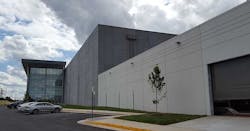CyrusOne Keeps Building, Acquiring New Site in Northern Virginia
CyrusOne has acquired land to continue its growth in the red-hot Northern Virginia data center market, the company said today. The property, which will be CyrusOne’s fourth campus in the region, includes an existing powered shell building, which will allow the company to complete the first phase of a new data center by early 2019.
“Hyperscalers demand warp speed, and we’re proud to be accelerating from zero to 160 in Northern Virginia, driven by demand from cloud and enterprise customers,” said Tesh Durvasula, chief commercial officer, CyrusOne.
Developers in Northern Virginia leased a record 115 megawatts of data center space in 2017, topping the 113 megawatts (MWs) absorbed the previous year. Now 2018 is shaping up as the biggest year yet for this market, as Northern Virginia is seeing unprecedented activity in both leasing and new construction.
Data center companies are buying up property for future expansion, a practice known as land banking, to ensure that they can secure capacity for customers seeking space in this strategic market.
CyrusOne has been actively scouting land acquisition, even as it continues to fill space in its massive Sterling V project, a 1 million square foot data center campus on Pacific Boulevard in Sterling. The expansion campus will be near one of the company’s existing campuses. The presence of a an existing powered shell – a finished building with infrastructure in place for power and fiber – will accelerate the company’s ability to deliver space quickly.
“Our land acquisition, development, construction, and capital markets teams continue to execute at a level unmatched in the industry to produce the inventory necessary to meet the ongoing need for new capacity in Northern Virginia and other key markets.” said Durvasula.
Land Banking Continues in Northern Virginia
The new campus will add 33 megawatts of capacity for CyrusOne, bringing the company’s total power capacity in Northern Virginia to more than 160 megawatts. CyrusOne is known for deploying new data center space quickly, placing it at the forefront of a trend in which the world’s largest hyperscale Internet companies have begun leasing cloud capacity from data center developers, rather than building their own server farms.
This trend is reshaping the market for wholesale data center space, as developers battle for mammoth “super-wholesale” leases that take down up to 35 megawatts of cloud capacity in a single transaction. These huge deals help hyperscalers keep pace with the rapid growth of their cloud operations, which has tested the limits of their in-house construction units. Leading wholesale data center providers have optimized their designs and supply chains to deliver lots of space, as quickly as possible.
Demand in Northern Virginia is coming from the traditional hyperscale providers (Facebook, Amazon, Google, Microsoft and Apple), who have now been joined by major Chinese cloud companies, who are said to be actively seeking space in Data Center Alley. In early 2018 there has also been a surge in demand from second-tier hyperscale players like Salesforce, Uber, Dropbox and Lyft, who are all seeking larger chunks of space than in the past.
CyrusOne entered the Northern Virginia market in 2015 with its Sterling I facility. In early 2016, CyrusOne completed its Sterling II facility, a fully pre-leased 30 megawatt data center just up the road from Sterling V, in just six months, establishing its ability to deliver space quickly. In August 2016, CyrusOne a building in Sterling with an agreement in hand to lease the entire 130,000 SF building to a hyperscale data center customer. In mid-2017 the company opened its Sterling V facility, its largest project yet.
But at the rate data center space is being gobbled up in Northern Virginia, even that huge building is not enough. The expansion announced today will add 33 megawatts by early next year. As hyperscale leases get bigger and bigger, that could represent a single deal. Odds are that the land banking in Northern Virginia will remain active, and we can expect CyrusOne to be an active player.
About the Author



